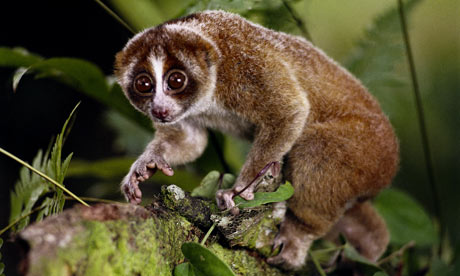Dusty Bake Activate
Fukk your corny debates



The Slow Loris: The Venomous Primate
The next revelation, shocked me even further, I learnt that they secrete toxic venom from their elbows, which they mix with saliva when they bite; as a result this makes the slow loris, one of the world’s venomous mammals. Moreover the slow loris is in fact a type of primate, the very same order of mammals that we belong to. I found it quite astounding to think that we have a poisonous relative somewhere out there.
The program explored exactly what the function of the venom was, the obvious answer was to capture and kill prey, like snakes and spiders do, but that wasn’t the full answer. Most of the loris’ prey is relatively small and would be easy to catch, even without the venom. The next theory mentioned by the scientist, Dr. Anna Nekaris, was that it served to protect the loris from biting insects and ticks. She remarked that she had never seen a cleaner mammal than the loris. I was particularly interested when she conducted an experiment using blood sucking Leeches. She placed several in a saucer and then dabbed them with a sample of the loris’ saliva, astonishingly all of the leeches died after just several minutes.
The next theory she postulated was that the venom acted as a defence against predators, and again she decided to conduct an experiment using a rattan basket, a towel covered in loris scent, two cotton buds dabbed with venom and a female sun bear. Anna placed the basket in the cage, and after a few moments the bear was released. Instantly the bear was intrigued clawing and sniffing at the basket, but as soon as she caught scent of the cotton bud, she bade a hasty retreat. But she did not give up, curiosity forced to investigate a further couple of times, but with the same result. So, the venom served as a defensive as well as an offensive weapon.
The final theory was perhaps the venom served as a weapon when males fight over territory or a mate. One of the shocking things about the venom is that who or whatever is the unlucky recipient of the bite is permanently scarred with wounds that never fully heal. Images were shown of loris’ with rather gruesome bald patches on their head and flanks. Anna herself had been the victim of a Loris bite, she told how the wound had bled consistently for several days, and even after a few months it still looked like a fresh cut.
To most westerners like me, the idea of a venomous ,ammal seemed absurd. But the people of South-East Asia have known this for centuries. Indeed when Anna interviewed a local tribal elder, he declared that he was far more scared of encountering a loris, than a spider or a scorpion. He also stated that he did not hunt the loris, he and his tribe just simply gave it a wide berth.




